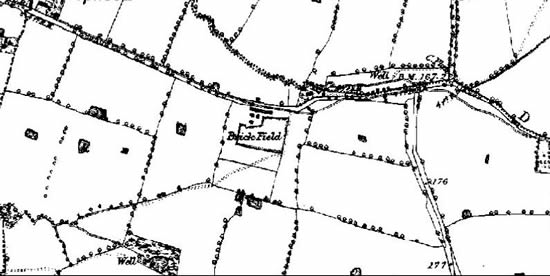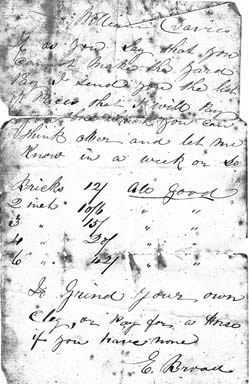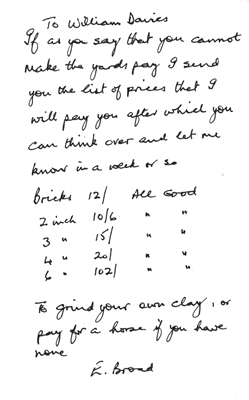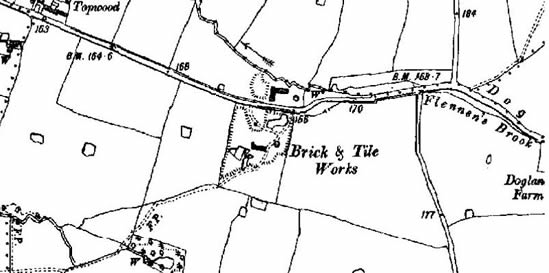Oldcastle Brick and Tile Works – known as The Brickyards.
By Dudley Realff
The exact starting date of this local business will almost certainly never be known as the full history has been most difficult to unearth! It was obviously started at a time when there was no obligation to affiliate or register the business of brick production and no trade body to monitor it. The information that we have has been gleaned from maps, trade directories and several local people who can still remember the enterprise, albeit during the latter part of its life.
The land was owned at that time by John Whitehall-Dod who had extensive holdings of land in Oldcastle. On the opposite side of the road, on a site that was to become another part of the enterprise, was a house and garden occupied by a James Harris. There were no brickworks on the Tithe Map of 1839 although by 1875 an OS shows a quite well developed enterprise (see map below) suggesting that the works probably started circa 1865. It was situated about 0.5 miles from Threapwood on the right hand side of Oldcastle Lane going towards Dog Lane and Malpas.
 |
OS dated 1875 |
In 1874 and up until 1892 an Edward Broad is listed as a Brick Maker. Below are the original and a copy of a note from Edward Broad to a William Davies who, it seems, may have been making bricks at Oldcastle or elsewhere. Broad is quoting brick sizes and their prices but does not specify quantities. It is believed that such quotations were given to local land owners and farmers who had sufficient and suitable quantities of good clay on their land. This clay could be dug and carted to the brickyards to be made into bricks or land tiles (drain pipes). Perhaps this relates to the reference on the quotation document/transcript ‘to grind your own clay or pay for a horse if you have none’. However, it is certain that at the end of the 19th C that the bricks from this site were moved by horse and cart or pony and trap. The latter would be loaded with 150 bricks.
 |
 |
| Original Quotation | Transcript |
Between 1892 and 1901 there are no brick makers mentioned in Kelly’s Directories although the business probably continued. In 1902 a James Cooper who lived at Dog Lane Farm is listed in Kelly’s as a farmer. In 1906 he is also noted as a brick maker. This continued until 1914 when he was listed with a Mr Robinson and an Arthur James. The OS map of 1910 shows the Brick and Tile Works on both sides of the road. The map below clearly shows five pits, three buildings and two kilns.
 |
OS Dated 1910 |
In 1919 James Cooper was reported to have sold Dog Lane Farm (however, local people remember the Coopers farming there until the late 90’s). In 1923 James Cooper is listed as a farmer only. The next listing of a brick maker at Oldcastle was in 1928 when Charles McHugh and J Richards were mentioned – however, by 1934 only McHugh was listed. The hiatus between 1923 and 1928 is interesting as Lucy Williams recollected that the brickworks were “out of action” around 1920 – temporarily it seems?
The Brickworks appear to have finally ceased production in the mid 30’s. There are two possible reasons for this cessation. Lucy Williams has said that the ‘good clay’ had been used up and that what was left produced ‘soft’ bricks. It is also quite likely that the industrial production of bricks was increasing rapidly offering cheaper prices, in greater quantities plus they would be readily available and delivered.
In 1937 Tarvin RDC recorded an agreement to rent a clay pit at Dog Lane for the purpose of depositing household refuse and a kiln now standing on the property (i.e. former brick kiln) at a rent of £4/annum to a Mr Robinson of Edge. Many locals can remember this on the left hand side becoming a rubbish dump. The site is landscaped and grassed over and now offers no clues to its history.
When in production both Lucy Williams and another person remember that the clay was barrowed out of the diggings, up planks, to the brick makers who it seems used leather fingerless gloves to handle the bricks (perhaps the fingers had been cut off standard gloves?). In later years the clay was loaded onto small trucks, set on rails, leading to the brick makers. The kilns were loaded and fired about once a week after the doors had been sealed. One can imagine that that the process could take a week with filling, firing, cooling and unloading.
How many people were employed, for how long, how much they were paid and how many bricks were made is not known although a correspondent (Albert H Humphreys) remembers a foreman, Dan Fowles, holding out successfully for an extra 0.5 pence/hr to become 1 shilling/hr – they were paid at 9.30 on a Saturday night!. One local resident remembers her grandfather working there but she does not have any further information. Lucy Williams remembers meeting men with their trousers ‘yorked’ (tied below the knee) coming from the works.
Alan Hooper (who has lived in America since the 50’s) has written in his memoirs “I can still remember vividly the old kilns on both sides of the road. They were domed in construction with small tunnels (*) on all four sides, I think to load in the bricks. The tops of the kilns were caved in at this time; this would be in the mid 1940’s. Next to the kiln on the north side of the road there was a deep clay pit that contained enough water in it for us to fish for roach, but it was also used as a rubbish tip, which slowly encroached on the water where I last remember it being nearly filled. The main area on the south side had more kilns and another deep clay pit which we allowed to fish in. I remember the pit being full of water where we would catch roach, perch and some large eels”. We think that these were likely to be air vents to the fire in the kiln?
 |
An example of a brick courtesy David Paton |
All that remains now are several pits on the right hand side of the road some filled with water and all surrounded by bulrushes. As with the other side of the road, there is no visible sign of what once went on here. And so, after 70 years or so, this rural industry closed. It had during its time provided employment, profit and must have made a significant contribution to the local economy. Its products would have been used in the construction of many properties in quite a wide area – some of which are known locally but in total, how many, we will never know.
Acknowledgements – David Hayns, Lucy Williams, Alan Hooper, Jill Lewis and Albert H Humphreys.
Notes & Queries relating to an 1896 Auction
We have recently been loaned a Sale Document dated 1896 which details what we understand to have been all or part of the Oldcastle Estate and it raises some interesting questions - particularly with what might relate to the Brick and Tile Works.
It seems that the Oldcastle Estate belonged to John Whitehall-Dod. In paragraphs 4 and 5 of the conditions of sale it states that he and his wife ‘of being without issue and with no prospect of issue would present no inheritance problems on their deaths’.
The auction particulars raise questions as whether James Cooper bought the Brickfield in 1896 plus Dog Lane Farm and did he sell Dog Lane Farm in 1919?
Are plots 17, 18 and 19 the same as those showing the Brickworks in the 1875 and 1910 OS Maps. The site of the first brickworks is shown on the 1836 - 1851 Tithe plot 164 (Cluttons Croft) and Tithe Plot 165 (Far Gate Field). The 1910 OS shows how the Brickworks has expanded beyond plot 164. The 1875 and 1910 OS show clearly how the Brick Field and Brickworks relate to plot 165.
Was the occupier of Topwood, in 1896, William Harris and was he related to James Harris the occupier of plots 163-4? Plot 153 was occupied by a Peter Fox.
R. Richards and C. Richards occupied The Greaves Farm and Dog Lane Farm, respectively and A.J. Richards was a listed Brick Maker with Chas McHugh in 1928 – were they all related?
